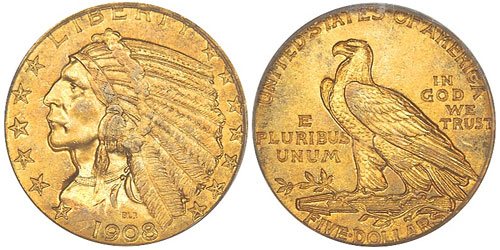Guide to U.S. Indian Half Eagles
The Indian Head Half Eagle was introduced in 1908, along with the quarter eagle of the same design. Both denominations featured an incuse design, with the various elements and inscriptions sunken below the surfaces of the coin. The half eagles would be produced each year from 1908 to 1916 and then for one final year in 1929. The series contains a total of twenty-four different circulation strikes from three different mint facilities. There are two rarities included, along with multiple issues which are elusive in higher uncirculated grades.

1908 Indian Head Half Eagle
By the early 20th century an increasing number of people, including President Theodore Roosevelt, had grown dissatisfied with United States circulating coin designs. It was believed that the national coinage should reflect the artistic skills of that country. Some of the designs had been introduced almost a lifetime earlier during the 1830’s, and the more recently introduced designs were not viewed as true pieces of art. Starting under the administration of President Roosevelt, all the circulating denominations would be redesigned, starting with the gold coins.
In 1907 the two larger gold denominations adopted new designs created by renowned sculptor Augustus Saint-Gaudens. The double eagle would feature a stunning full-figure portrayal of Liberty, while the eagle would feature the head of Liberty wearing an Indian war bonnet. Following the untimely passing of Saint-Gaudens, the redesign process would continue with the two smaller gold denominations.
Dr. William Sturgis Bigelow, a close friend of President Roosevelt, is generally believed to have suggested the use of incuse designs for the remaining gold coins. The idea fit with Roosevelt’s desire to make the gold coins resemble those of Ancient Greece, which were considered to be of true grandeur. After receiving Roosevelt’s approval, Bigelow contacted Boston sculptor Bela Lyon Pratt to design the new coins. Communications related to the new designs between Bigelow, Pratt, and Roosevelt began as early as October 1907.
Obverse design
The designs for the half eagle and quarter eagle were finalized in late June of 1908 and production began during the last few months of the same year. The obverse of the Indian Head Half Eagle features the bust of a Native American male chief wearing a ceremonial headdress. The word LIBERTY appears above and the date appears below. The design is completed with thirteen stars, arranged six to the left and seven to the right.
Reverse design
The reverse features an eagle perched on a bundle of arrows intertwined with an olive branch. The inscriptions surround the image, with UNITED STATES OF AMERICA appearing above, E PLURIBUS UNUM appearing to the left, and IN GOD WE TRUST appearing to the right. Lastly, the denomination expressed as 5 DOLLARS is positioned below.
Early reactions to the newly designed half eagle and quarter eagle included criticism from newspapers and some members of the public. They expressed fears that the incuse designs would capture disease-bearing dirt and quickly become unsightly within circulation. Other concerns included possible difficulty in stacking the coins and susceptibility to counterfeiting. These criticisms were all unfounded and ultimately dismissed. The designs are now widely viewed as beautiful and unique expressions of art within American numismatics.

